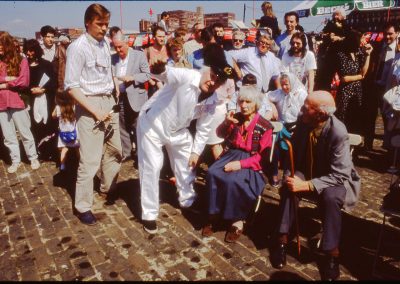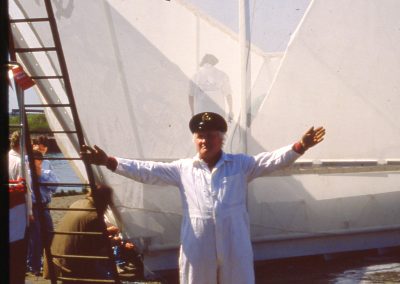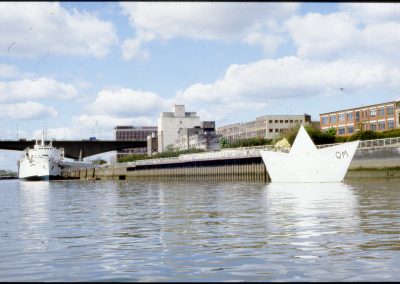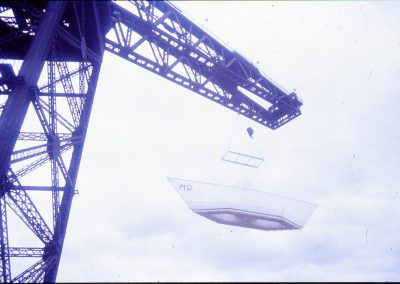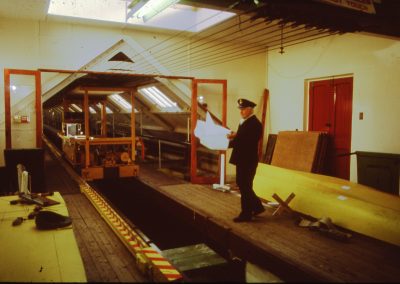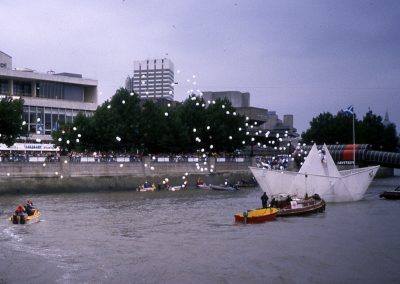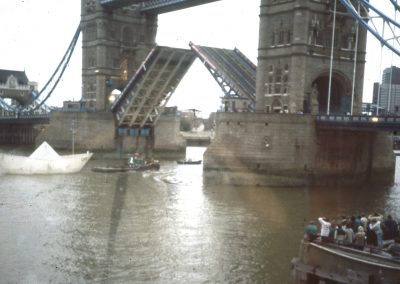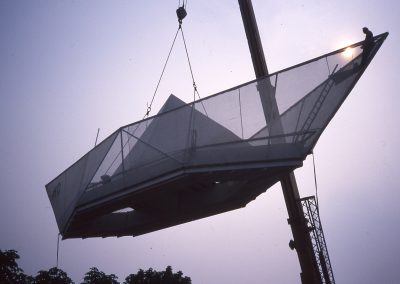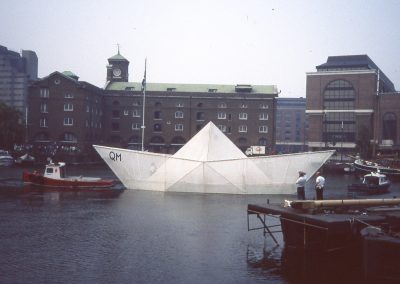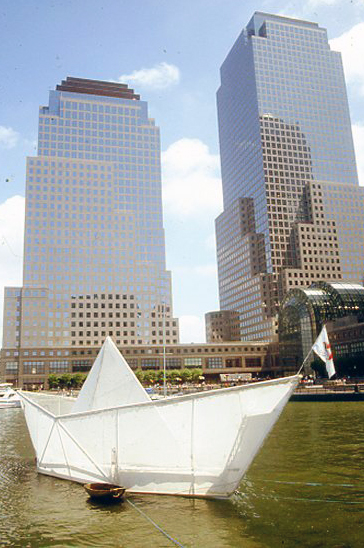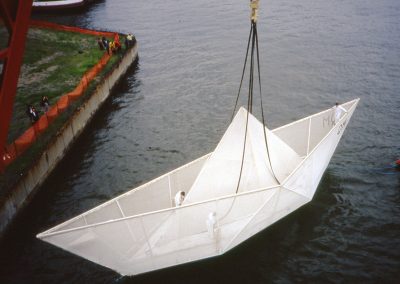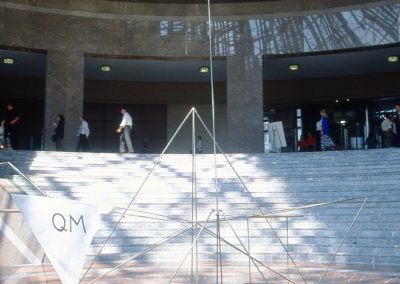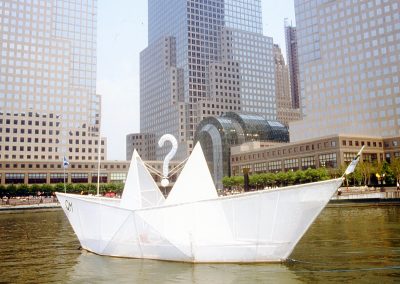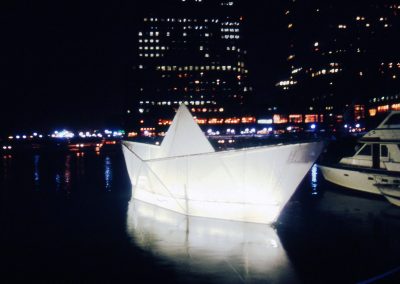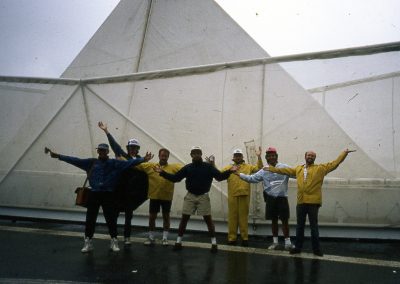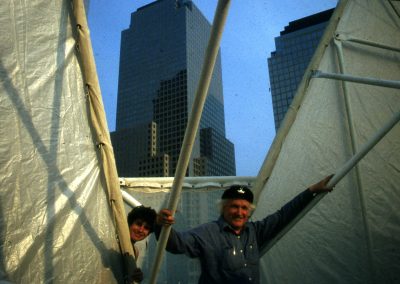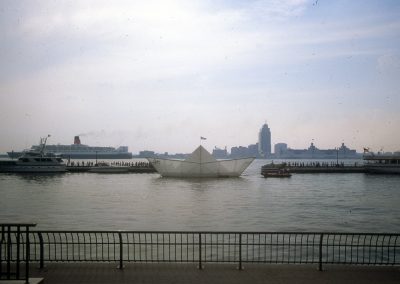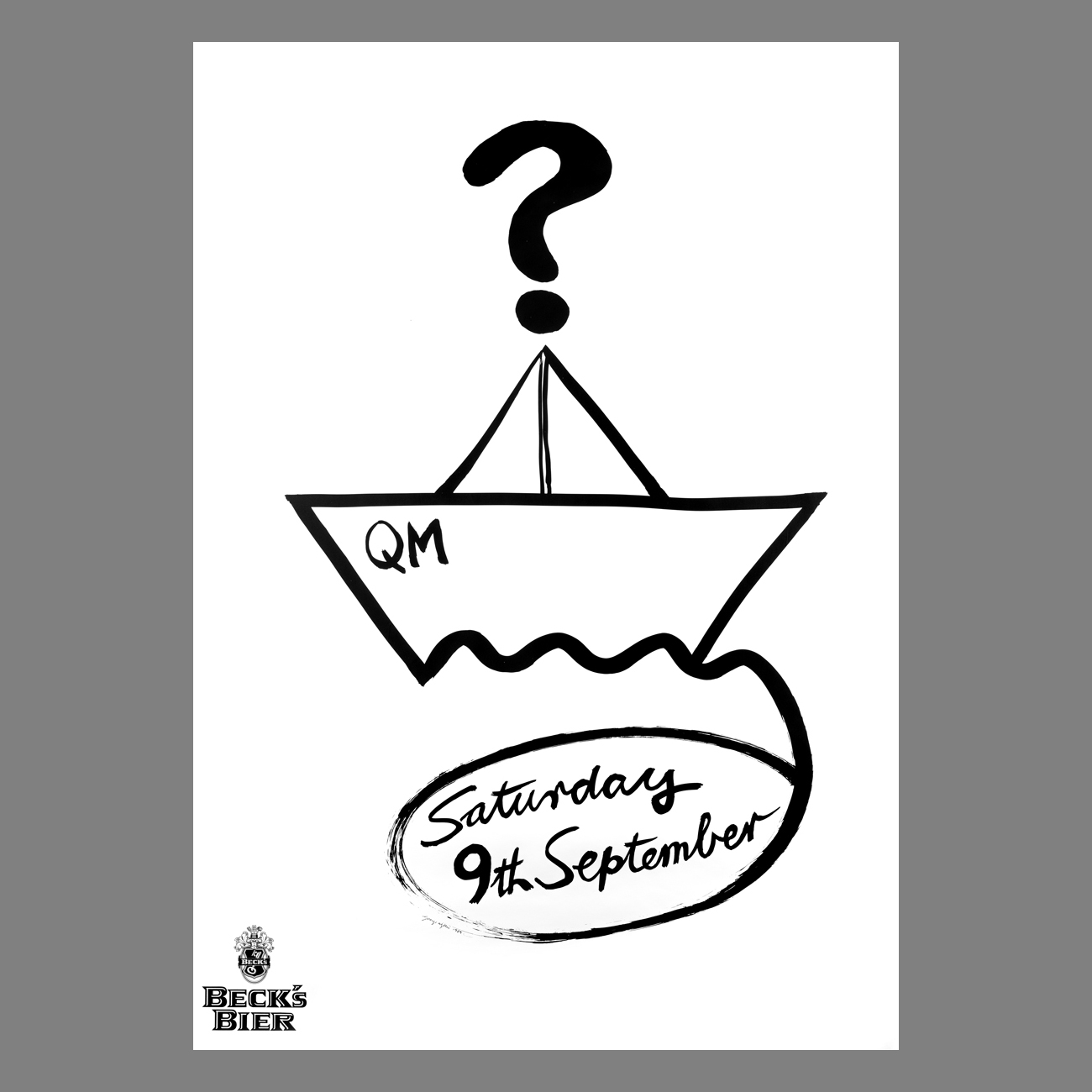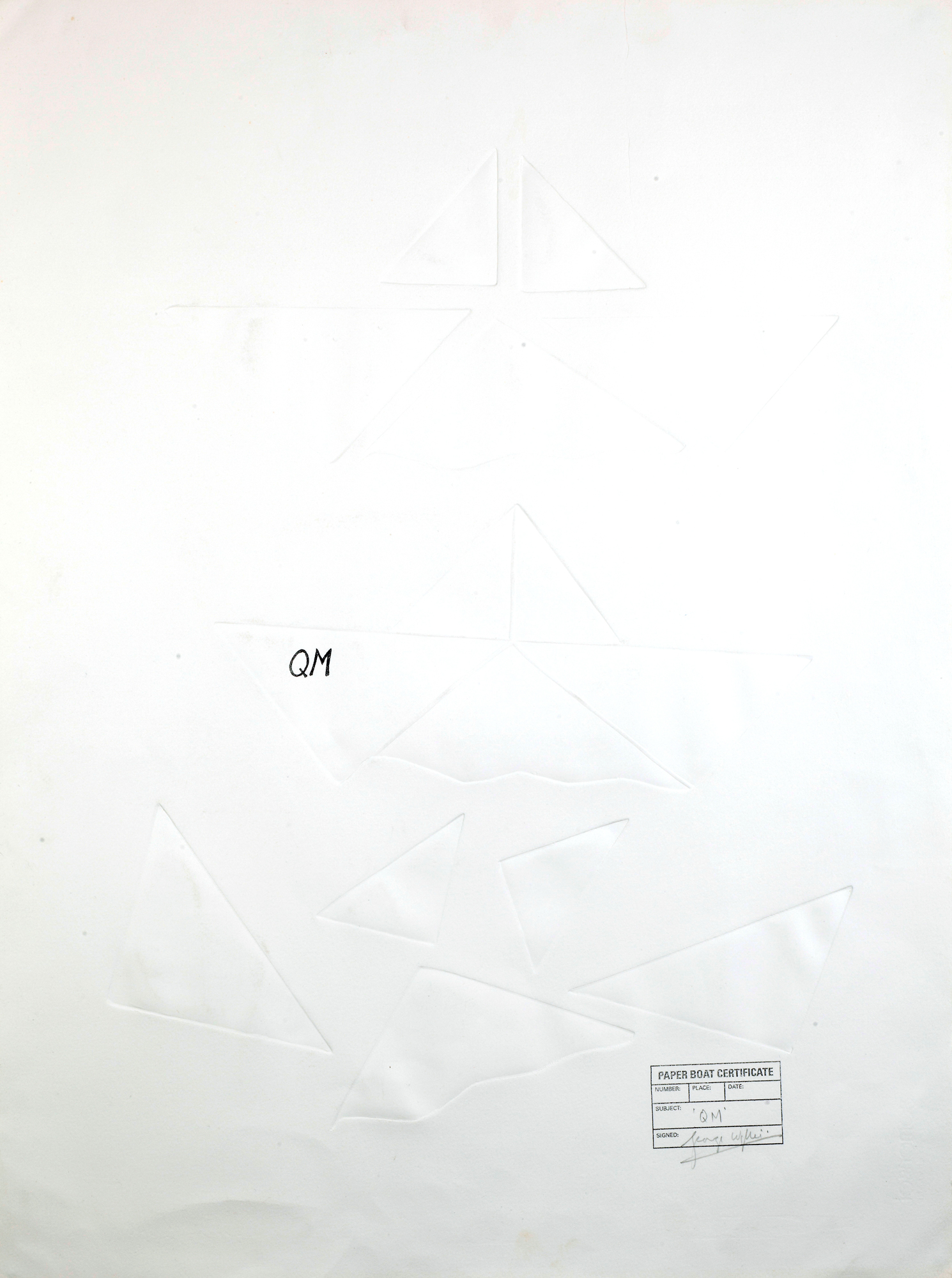THE PAPER BOAT

Date: 1989 – 1990
Location: Glasgow, London, New York, Antwerp
Type: sculpture, installation, performance
Material: Paper?
Length: 80ft
Height: 28ft
Width: 18ft
The Paper Boat Song
George’s dismay at the virtual disappearance of Glasgow’s once mighty shipbuilding industry drove his Paper Boat. Fusing engineering, street theatre, visual art, performance and music in one provocatively playful package, the boat had a steel frame clad in sheets of plastic and gauze Velcroed together, which opened to reveal a viewing platform.
George’s dismay at the virtual disappearance of Glasgow’s once mighty shipbuilding industry drove his Paper Boat. Fusing engineering, street theatre, visual art, performance and music in one provocatively playful package, the boat had a steel frame clad in sheets of plastic and gauze Velcroed together, which opened to reveal a viewing platform.
There was, naturally, an elevating question mark inside, but this time George wanted the simplistic beauty of the sculpture to be appreciated in equal measure to the political content. He was heavily influenced by French poet Arthur Rimbaud’s “Drunken Boat” poem, the first line of which describes a something or someone in a boat “floating down unconcerned rivers” being “steered by the Haulers”.
The narrator describes gliding down calm rivers to tide water, and then for ten nights being tossed about by the tumultuous waters of the open sea. The experience is a joyful one, and at the end the speaker has a feeling of freedom and purification. The Paper Boat carried the initials “QM”, but George admitted later that “we were never sure what QM stood for. It’s always good not to know something about what you’re doing. We had notions it might mean Queen Mary or Question Mark or Questioning Mind”. He made the boat in collaboration with Harry Finlay of the Greenock Welding Company. The two men worked together on Straw Locomotive but had enjoyed a fruitful relationship going back to the 1970s.
In order to be legally seaworthy, George tested the 78ft-long Paper Boat at the Denny Tank in Dumbarton. This was the test facility where designs for the massive Clyde-built ships were undertaken. She was then certified with Lloyd’s to complete the paperwork side.
The launch of the pride of The Origami Line (with the letters QM on her hull) took place on a beautiful sunny day on 6 May 1989 in front of a large crowd, and echoed the celebratory launches which once routinely took place on shipyards on the banks of the Clyde. (The title was a nod to the Japanese art of paper folding and a subliminal reference to the time he spent in Japan during the war.) There was even a blessing by industrial chaplain Revd Norman Orr and a naming ceremony by the writer Naomi Mitchison. Accompanied by the Da Capo Choir from Greenock, George, in his pristine white boiler suit and captain’s hat, performed “a corny wee tune, a paddle-steamer song” which he’d composed for the occasion. It begins:
So now that we’re building a Paper Boat,
A Paper Boat Paper Boat
don’t-be-surprised-at-the-way-we-vote.
(We’re going to build a big Paper Boat,
A Paper Boat Paper Boat
folded up carefully so it can float
– but not what a ship used to be.
George maintained that he wasn’t nostalgic about shipbuilding, but rather for the skills and the spirit that went into it, and the transcending of the tough conditions of the shipyards. Where was this energy now? he asked, as his “paper” boat travelled to London and made a splash there. In Murray Grigor’s The Why?s Man, which also documented his Paper Boat project, he quipped that “on paper” he was the only shipbuilder left on the Clyde.
The idea of social sculpture, a concept mooted by his guru, Joseph Beuys, was the major driving force behind both Straw Locomotive and Paper Boat. Paper Boat referenced Joseph Beuys’ idea of a journey, one that took it from Glasgow to Liverpool and on to London, New York, Antwerp, Dumfries and the east coast of Scotland.
In his art, which encompassed drawing, sculpture, painting and performance, Joseph Beuys wanted to take both himself and the audience on a literal and figurative journey which would transform their idea of society. There was also a strong aspect of the healing effect of art in all of his work. He often incorporated deeply personal motifs into his work, such as animal fat and felt, which had profound meaning to him. Both organic materials related to his wartime experience serving with the Luftwaffe, and it was his conviction that if he felt a profound connection, then the audience would feel it too. George, himself an ex-serviceman – also profoundly affected by his time in the Royal Navy – espoused this idea wholeheartedly.
George received support for his Paper Boat events from Beck’s Beer, who even produced limited edition Paper Boat-labelled bottles, part of a long-running Beck’s Art Labels project, which started in 1987. The first to be featured in the series were Gilbert & George, and since then the list has grown to include names such as Tracey Emin, Damien Hirst, Jeff Koons and Andy Warhol.
In September 1989, Paper Boat travelled to London, and on Thames Day (9 September) it sailed under Tower Bridge to the Houses of Parliament. As a patriotic gesture, the question mark inside the Paper Boat this time was red, white and blue. George’s prime aim in London was to draw attention to Thatcher’s policies, including the privatisation of the shipbuilding industry. In order to ensure that Tower Bridge had to be opened, a tall mast was added, flying the Scottish Saltire. Traffic was stopped, the bridge was opened and the Paper Boat sailed through and was moored opposite the Palace of Westminster. The questions, as well as the bridge, had been raised. But George was not happy. According to his friend and frequent helpmate Pete Searle, George cried when he discovered Thatcher was not there to see the boat opening up to reveal a giant question mark. As always, there was a little detail which kept the project grounded; George had borrowed the Union Jack flag which flew on the Paper Boat from the Inverkip Scouts. (His nephew Alistair, like his father Banks, was, and remains, a key figure in the scouting movement.)
The following summer, in July 1990, Paper Boat sailed up the Hudson and into the World Financial Center in New York accompanied, to George’s delight, by the Duke Ellington Band. On docking, George sang the Paper Boat Song accompanying himself on the ukulele, and then, as the question mark was revealed, four Scottish pipers played. He took a spire with him as he went ashore to celebrate the “place in which it stood”. He then opened a golden suitcase and took out the “ship’s log”. The purpose of the Paper Boat, George told bystanders, was to make things “plain; clear; open and visible”, and he added that he intended to do just that. The boat created a real splash by making it onto the front page of the Wall Street Journal. The headline on 16 July 1990 read: “Laugh You May, but Remember It’s Floating and the Titanic Isn’t”. For its New York jaunt, George had included notations inside the boat from Scots economist Adam Smith’s The Theory of Moral Sentiments. The newspaper wrote: “Mr Wyllie says Wall Street has forgotten The Theory of Moral Sentiments, Mr Smith’s companion [to The Wealth of Nations] treatise on conscience and morality.” George’s timing was important as the bicentenary of Smith’s classic text on capitalism, The Wealth of Nations, was celebrated in 1990. He then read the first sentence from Theory of Moral Sentiments.
How selfish soever man may be supposed, there are evidently some principles in his nature, which interest him in the fortune of others, and render their happiness necessary to him, though he derives nothing from it except the pleasure of seeing it.
The boat was taken on many journeys, but eventually George sent it to a shipyard at Inverkeithing and had it broken up like a real liner. He recycled the material and made a giant goose, which he called “Truce Goose”, for a project in 1993 about a compromise between farmers and conservationists over the thousands of geese which consumed huge amounts of grass on the Hebridean island of Islay every year.
From Arrivals and Sailings: The Making of George Wyllie by Louise Wyllie and Jan Patience
Related content:
No Results Found
The page you requested could not be found. Try refining your search, or use the navigation above to locate the post.


